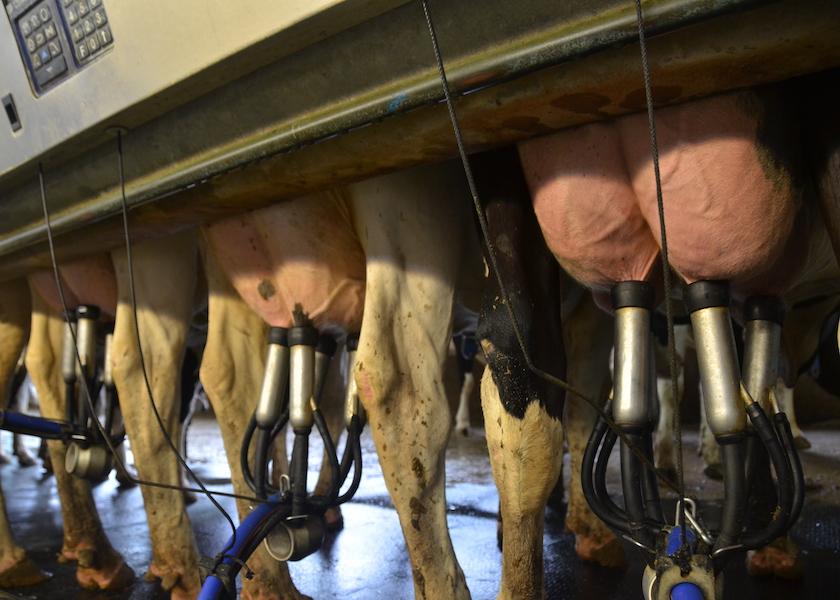A 360° Approach to Mastitis Management

Mastitis can strike from any direction. Successful management requires a 360-degree approach, 365 days a year.
The first step to successfully preventing and treating mastitis is understanding the disease in all its forms. Mastitis infections are divided into one of two categories — environmental or contagious — based on the source of the infection.
“An environmental infection is picked up when a cow is exposed to the bacteria anywhere in her environment,” explained Curt Vlietstra, DVM, Boehringer Ingelheim. “A contagious infection is acquired when bacteria are transferred from one cow to another, often taking place during the milking process.”
Mastitis infections can be further categorized as clinical or subclinical, based on the level of inflammation. “Depending on the pathogen, the infection can result in visible changes in the milk, or there may be no visible abnormalities at all,” said Dr. Vlietstra. “Clinical mastitis is when a cow or her milk has obvious signs of infection, whereas in subclinical mastitis, the milk is not abnormal to the eye, but may still carry the bacteria.”
Understanding the infection is a good foundation to a successful mastitis management program. Dairy producers can take this knowledge to the next step with strategies designed to prevent infection and with treatment options proven to provide results. To establish a comprehensive approach, Dr. Vlietstra recommends focusing on the following:
Cow comfort — “Having cows that are well fed and well taken care of is key to the animals’ high-functioning immune system,” noted Dr. Vlietstra. Good animal husbandry is central to cow comfort, and cow comfort is an essential part of reducing environmental risks for mastitis.1
Scott Earnest, DVM, of ProAGtive Technologies in Wisconsin, weighed in on this idea. “I think you have to be looking at all aspects of the cow’s experience,” he said. “A cow’s environment and ration contribute to her overall immunity and well-being. We want to put our cows in the best position possible to navigate health challenges.”
The following actions are at the heart of ensuring dairy cattle comfort:
* Ensure adequate stocking density
* Arrange appropriate water and feed bunk space
* Provide comfortable and clean bedding
* Install or maintain proper cooling systems
* Limit moves from one pen to another
* Maintain an overall atmosphere of cleanliness
Parlor procedure — Maintaining teat health and decreasing exposure to potential pathogens should be a priority during milking. “Strive to have a clean parlor, well-maintained milking equipment and a sound milking procedure,” said Dr. Vlietstra.
He recommended sitting down with all parlor employees on a quarterly basis for a training review to ensure milking procedure is both understood and being followed.
Record keeping — Records can help producers easily track potential factors contributing to a mastitis outbreak and determine the effectiveness of current treatment protocols.
“Having key people on your team who are keeping and analyzing records allows you to watch for opportunities to improve milk quality, and to decide if you are using the right products and treating the right cows,” Dr. Earnest asserted.
Health protocol — Your herd veterinarian is your best resource for treatment considerations. He or she can help develop an approach best tailored to your operation’s needs. Dr. Vlietstra described three key things to include in your conversation with them:
1 - Prevention procedures. Administration of a coliform mastitis vaccine can help reduce the severity and incidence of coliform mastitis. The vaccine you choose <http://email.broadheadco.com/c/eJwdjs1uhDAQg58GbqDJ5P_AoVK17xFmJoItNAiyy-s3W8kH27Ksj6ccQLncrxMCNoFC0KBgFB91pEwxaued5s7AfJbEiySmMlLZ-2USVAbZK2cxGglkMKM2NmCyFGagfpuWWo-r018dPpru-x7ndXhL3YVXSp-fVl-H0CpXc5Rq3aSZ4yz8ovrpnsM7UacftHKnv2UfspPM0J_T2ZDKz9XYcjr3Z3mdv2n7Z6uThMDKiY0WWZJD7WdyAMF5E8H51CZsQFRLs1WYlI0qBMwemU0Uspz_AE5FVYI> should have a short meat withdrawal and provide protection against E. coli, endotoxemia caused by E. coli and Salmonella Typhimurium.
2 - A plan for treatment at dry off. Administering an antibiotic at dry off can treat current subclinical infections and prevent new infections during the dry period.
Since 95% of infections at dry off are caused by Gram-positive pathogens,2 Dr. Vlietstra recommends choosing a dry cow antibiotic mastitis treatment that protects against Gram-positive bacteria <http://email.broadheadco.com/c/eJwdjk1uhTAQg08DO9DkP1mweFLVeyQzE0ELDQp5pb198yp5YVuW9dGSPQibx22RILtASFAgYGYXVMCMISjrrKJBQ6ol0sqRsMxYjnFdnEiGUaNz3igw6LNVzgjLXpDTMY37srZ2XoN6DPK9677vOW3TN7eDacP4-un1dTJufHWHsbWduzlroSe2V0f1d8K9_MxrO_ZB9R-LGw3qjY_JebRsxrrUTlc-r46ZYz0-yrN-xf0fsy3sPXUoE4wkjlYql9ACeOt0AOtin5AGFj0lI2QUJgjvZXaSSAdGQ_kPbKVZOg> including Streptococcus (Strep) and Staphylococcus (Staph) species.
Another way to prevent new infections during the dry period is by using an internal teat sealant. <http://email.broadheadco.com/c/eJwdjs1uwzAMg58muS2Qrfjv4MOAoe-hSDLSNa2LxEVef84AXggS_Ci5RDC-jPdswXaBsYBgYNKQMHHhlNAHjzLMsOyVZFUSrhPX57jmwOKCKbMtzDEweRMKIgB6EymBHbe8tvY-Bvwe7K3rPM9pq_yon9aU2qG00atda1eON77LgD_6_OLrho573ju1Po6OL7Q_f-tnf9H2j29ZYxTj1SVnRclbDAt7gOjDnMAH6hWZQU13izOWjEsmRluCFZmTspPyB8cOS6w> While cows are naturally protected from intramammary infections by the formation of a keratin plug, time of closure varies, and sometimes the plug won’t form at all. A teat sealant can further prevent exposure by supplementing the natural plug.
3 - Judicious antibiotic use.
Although every cow should be treated with an internal teat sealant at dry off, not every cow needs to be treated with an antibiotic. Selective dry cow therapy (SDCT) is an alternative to blanket dry cow therapy in which antibiotics are only used to treat cows with likely intramammary infections.
“It’s largely an economic and antibiotic stewardship decision to use less product on a preventive basis,” said Dr. Earnest. “SDCT can offer a more targeted approach, but it isn’t a viable option for everyone. Talk with your veterinarian to discuss implementation options.”
If you find yourself wondering which cows to treat, culturing can be another great tool to use and a new way to gain insight. “Culturing is the gold standard in terms of making sure we are only treating cows that need to be treated,” emphasized Dr. Vlietstra.
“We use culturing widely for analyzing the successes and failures of different treatment programs,” added Dr. Earnest. “It’s helpful for identifying contagious pathogens, figuring out what mastitis cases are likely to cure, and which ones might be more challenging.
“At the end of the day, your program is only going to be as strong as the weakest part,” Dr. Earnest concluded. “You could have a phenomenal vaccination program, completely undercut by cows that are systemically unwell or by a poor-quality environment. That is why we look at udder health from every angle.”







